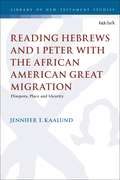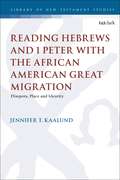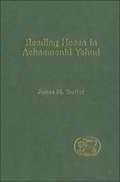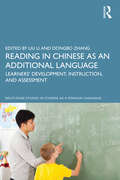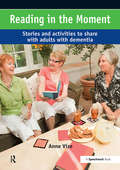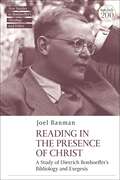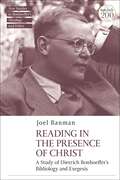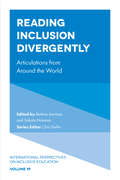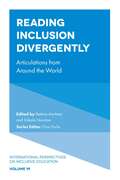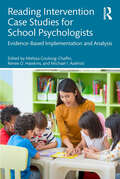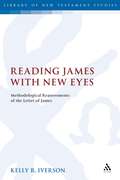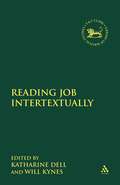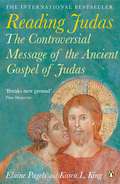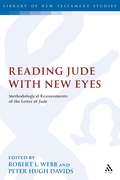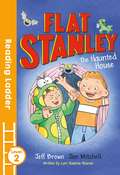- Table View
- List View
Reading Hebrews and 1 Peter with the African American Great Migration: (dis)locating Diaspora (The Library of New Testament Studies)
by Dr Jennifer T. KaalundKaalund examines the constructed and contested Christian-Jewish identities in Hebrews and 1 Peter through the lens of the "New Negro,†? a diasporic identity similarly constructed and contested during the Great Migration in the early 20th century. Like the identity "Christian,†? the New Negro emerged in a context marked by instability, creativity, and the need for a sense of permanence in a hostile political environment. Upon examination, both identities also show complex internal diversity and debate that disrupts any simple articulation as purely resistant (or accommodating) to its hegemonic and oppressive environment. Kaalund's investigation into the construction of the New Negro highlights this multiplicity and contends that the rhetoric of place, race, and gender were integral to these processes of inventing a way of being in the world that was seemingly not reliant on one's physical space. Putting these issues into dialogue with 1 Peter and Hebrews allows for a reading of the formation of Christian identity as similarly engaging the rhetoric of place and race in constructive and contested ways.
Reading Hebrews and 1 Peter with the African American Great Migration: Diaspora, Place and Identity (The Library of New Testament Studies)
by Dr Jennifer T. KaalundKaalund examines the constructed and contested Christian-Jewish identities in Hebrews and 1 Peter through the lens of the "New Negro,†? a diasporic identity similarly constructed and contested during the Great Migration in the early 20th century. Like the identity "Christian,†? the New Negro emerged in a context marked by instability, creativity, and the need for a sense of permanence in a hostile political environment. Upon examination, both identities also show complex internal diversity and debate that disrupts any simple articulation as purely resistant (or accommodating) to its hegemonic and oppressive environment. Kaalund's investigation into the construction of the New Negro highlights this multiplicity and contends that the rhetoric of place, race, and gender were integral to these processes of inventing a way of being in the world that was seemingly not reliant on one's physical space. Putting these issues into dialogue with 1 Peter and Hebrews allows for a reading of the formation of Christian identity as similarly engaging the rhetoric of place and race in constructive and contested ways.
Reading Hosea in Achaemenid Yehud (The Library of Hebrew Bible/Old Testament Studies)
by James M. TrotterAn examination of the final form of Hosea within the socio-historical context of Persian period Judah, making use of insights from historical-critical and reader-oriented perspectives. The amalgamation of these two seemingly divergent approaches creates a framework within which the setting and interpretive practices of both the modern critic and the ancient reader(s) can be taken seriously. The resulting examination proposes a reading of Hosea shaped, as far as possible, by the reading conventions and socio-religious concerns of Persian period Judahites.
Reading in Asian Languages: Making Sense of Written Texts in Chinese, Japanese, and Korean
by Ken Goodman Shaomei Wang Mieko Shimizu Iventosch Yetta GoodmanReading in Asian Languages is rich with information about how literacy works in the non-alphabetic writing systems (Chinese, Japanese, Korean) used by hundreds of millions of people and refutes the common Western belief that such systems are hard to learn or to use. The contributors share a comprehensive view of reading as construction of meaning which they show is fully applicable to character-based reading. The book explains how and why non-alphabetic writing works well for its users; provides explanations for why it is no more difficult for children to learn than are alphabetic writing systems where they are used; and demonstrates in a number of ways that there is a single process of making sense of written language regardless of the orthography. Unique in its perspective and offering practical theory-based methodology for the teaching of literacy in Chinese, Japanese, and Korean to first and second language learners, it is a useful resource for teachers of increasingly popular courses in these languages in North America as well as for teachers and researchers in Asia. It will stimulate innovation in both research and instruction.
Reading in Asian Languages: Making Sense of Written Texts in Chinese, Japanese, and Korean
by Kenneth S. Goodman Shaomei Wang Mieko Iventosch Yetta M. GoodmanReading in Asian Languages is rich with information about how literacy works in the non-alphabetic writing systems (Chinese, Japanese, Korean) used by hundreds of millions of people and refutes the common Western belief that such systems are hard to learn or to use. The contributors share a comprehensive view of reading as construction of meaning which they show is fully applicable to character-based reading. The book explains how and why non-alphabetic writing works well for its users; provides explanations for why it is no more difficult for children to learn than are alphabetic writing systems where they are used; and demonstrates in a number of ways that there is a single process of making sense of written language regardless of the orthography. Unique in its perspective and offering practical theory-based methodology for the teaching of literacy in Chinese, Japanese, and Korean to first and second language learners, it is a useful resource for teachers of increasingly popular courses in these languages in North America as well as for teachers and researchers in Asia. It will stimulate innovation in both research and instruction.
Reading in Chinese as an Additional Language: Learners’ Development, Instruction, and Assessment (Routledge Studies in Chinese as a Foreign Language)
by Liu Li Dongbo ZhangReading in Chinese as an Additional Language focuses on Chinese literacy acquisition, which has been considered most difficult by both learners and teachers of Chinese as an additional language (CAL). Three major areas are covered: (1) acquisition of Chinese characters; (2) reading comprehension subskills and reader’s identity; (3) reading instruction and assessment. The first part delves into the foundation of Chinese literacy development—how to learn and teach Chinese characters. The second part examines various learners’ reading comprehension subskills, as well as the evolution of learners’ literacy identity. The third part explores effective instructional methods and assessment practices for CAL reading development. Theoretically, this book provides frameworks and evidence from both cognitive and sociocultural perspectives on the nature of CAL reading development. Pedagogically, the book showcases how to teach and assess CAL reading skills. Methodologically, this book includes empirical studies using both qualitative and quantitative methods. In terms of scope, the book covers a much broader spectrum of issues about CAL reading research and classroom teaching than has previously been available. Writing is also discussed in several chapters. In terms of technology, the book includes discussion on how the use of computers, the Internet, and social media impacts students’ Chinese literacy acquisition. This book will help CAL researchers and educators better understand the nature of CAL reading development and become well informed about CAL classroom teaching and assessment, including the application of interactive approaches to teaching and assessing diverse reading skills.
Reading in Chinese as an Additional Language: Learners’ Development, Instruction, and Assessment (Routledge Studies in Chinese as a Foreign Language)
by Liu Li Dongbo ZhangReading in Chinese as an Additional Language focuses on Chinese literacy acquisition, which has been considered most difficult by both learners and teachers of Chinese as an additional language (CAL). Three major areas are covered: (1) acquisition of Chinese characters; (2) reading comprehension subskills and reader’s identity; (3) reading instruction and assessment. The first part delves into the foundation of Chinese literacy development—how to learn and teach Chinese characters. The second part examines various learners’ reading comprehension subskills, as well as the evolution of learners’ literacy identity. The third part explores effective instructional methods and assessment practices for CAL reading development. Theoretically, this book provides frameworks and evidence from both cognitive and sociocultural perspectives on the nature of CAL reading development. Pedagogically, the book showcases how to teach and assess CAL reading skills. Methodologically, this book includes empirical studies using both qualitative and quantitative methods. In terms of scope, the book covers a much broader spectrum of issues about CAL reading research and classroom teaching than has previously been available. Writing is also discussed in several chapters. In terms of technology, the book includes discussion on how the use of computers, the Internet, and social media impacts students’ Chinese literacy acquisition. This book will help CAL researchers and educators better understand the nature of CAL reading development and become well informed about CAL classroom teaching and assessment, including the application of interactive approaches to teaching and assessing diverse reading skills.
Reading in the Digital Age: International Studies with E-books in Diverse Contexts (Literacy Studies #18)
by Ji Eun Kim Brenna Hassinger-DasThis edited book focuses on affordances and limitations of e-books for early language and literacy, features and design of e-books for early language and literacy, print versus e-books in early language and literacy development, and uses of and guidelines for how to use e-books in school and home literacy practices. Uniquely, this book includes critical reviews of diverse aspects of e-books (e.g., features) and e-book uses (e.g., independent reading) for early literacy as well as multiple examinations of e-books in home and school contexts using a variety of research methods and/or theoretical frames. The studies of children’s engagement with diverse types of e-books in different social contexts provide readers with a contemporary and comprehensive understanding of this topic. Research has demonstrated that ever-increasing numbers of children use digital devices as part of their daily routine. Yet, despite children’s frequent use of e-books from an early age, there is a limited understanding regarding how those e-books are actually being used at home and school. As more e-books become available, it is important to examine the educational benefits and limitations of different types of e-books for children. So far, studies on the topic have presented inconsistent findings regarding potential benefits and limitations of e-books for early literacy activities (e.g., independent reading, shared reading). The studies in this book aim to fill such gaps in the literature.
Reading in the Moment: Activities and Stories to Share with Adults with Dementia
by Anne VizeStudies have shown that reading in a melodic and rhythmic voice can produce positive changes in mood, emotion and behaviour in those with dementia. This book features: a detailed section on the background of how and what to read to those with dementia, as well as the research behind bibliotherapy.
Reading in the Moment: Activities and Stories to Share with Adults with Dementia
by Anne VizeStudies have shown that reading in a melodic and rhythmic voice can produce positive changes in mood, emotion and behaviour in those with dementia. This book features: a detailed section on the background of how and what to read to those with dementia, as well as the research behind bibliotherapy.
Reading in the Presence of Christ: A Study Of Dietrich Bonhoeffer's Bibliology And Exegesis (T&T Clark New Studies in Bonhoeffer’s Theology and Ethics)
by Joel BanmanBonhoeffer's writings include a significant amount of biblical interpretation, but his potential contributions in the fields of biblical studies and theological exegesis of Scripture have not been sufficiently explored. This study reassesses some of his key exegetical writings in light of his theology of revelation and bibliology, unfolding the ways in which his reading of the Bible is determined by his theology of Scripture. Through this analysis, Joel Banman demonstrates that the uniting factor of Bonhoeffer's biblical interpretation is not methodological but bibliological: he reads Scripture as the living word of the present Christ.
Reading in the Presence of Christ: A Study of Dietrich Bonhoeffer's Bibliology and Exegesis (T&T Clark New Studies in Bonhoeffer’s Theology and Ethics)
by Joel BanmanBonhoeffer's writings include a significant amount of biblical interpretation, but his potential contributions in the fields of biblical studies and theological exegesis of Scripture have not been sufficiently explored. This study reassesses some of his key exegetical writings in light of his theology of revelation and bibliology, unfolding the ways in which his reading of the Bible is determined by his theology of Scripture. Through this analysis, Joel Banman demonstrates that the uniting factor of Bonhoeffer's biblical interpretation is not methodological but bibliological: he reads Scripture as the living word of the present Christ.
Reading in the Wild: The Book Whisperer's Keys to Cultivating Lifelong Reading Habits
by Donalyn MillerIn Reading in the Wild, reading expert Donalyn Miller continues the conversation that began in her bestselling book, The Book Whisperer. While The Book Whisperer revealed the secrets of getting students to love reading, Reading in the Wild, written with reading teacher Susan Kelley, describes how to truly instill lifelong "wild" reading habits in our students. Based, in part, on survey responses from adult readers as well as students, Reading in the Wild offers solid advice and strategies on how to develop, encourage, and assess five key reading habits that cultivate a lifelong love of reading. Also included are strategies, lesson plans, management tools, and comprehensive lists of recommended books. Copublished with Editorial Projects in Education, publisher of Education Week and Teacher magazine, Reading in the Wild is packed with ideas for helping students build capacity for a lifetime of "wild" reading. "When the thrill of choice reading starts to fade, it's time to grab Reading in the Wild. This treasure trove of resources and management techniques will enhance and improve existing classroom systems and structures." —Cris Tovani, secondary teacher, Cherry Creek School District, Colorado, consultant, and author of Do I Really Have to Teach Reading? "With Reading in the Wild, Donalyn Miller gives educators another important book. She reminds us that creating lifelong readers goes far beyond the first step of putting good books into kids' hands." —Franki Sibberson, third-grade teacher, Dublin City Schools, Dublin, Ohio, and author of Beyond Leveled Books "Reading in the Wild, along with the now legendary The Book Whisperer, constitutes the complete guide to creating a stimulating literature program that also gets students excited about pleasure reading, the kind of reading that best prepares students for understanding demanding academic texts. In other words, Donalyn Miller has solved one of the central problems in language education." —Stephen Krashen, professor emeritus, University of Southern California
Reading in the Wild: The Book Whisperer's Keys to Cultivating Lifelong Reading Habits
by Donalyn MillerIn Reading in the Wild, reading expert Donalyn Miller continues the conversation that began in her bestselling book, The Book Whisperer. While The Book Whisperer revealed the secrets of getting students to love reading, Reading in the Wild, written with reading teacher Susan Kelley, describes how to truly instill lifelong "wild" reading habits in our students. Based, in part, on survey responses from adult readers as well as students, Reading in the Wild offers solid advice and strategies on how to develop, encourage, and assess five key reading habits that cultivate a lifelong love of reading. Also included are strategies, lesson plans, management tools, and comprehensive lists of recommended books. Copublished with Editorial Projects in Education, publisher of Education Week and Teacher magazine, Reading in the Wild is packed with ideas for helping students build capacity for a lifetime of "wild" reading. "When the thrill of choice reading starts to fade, it's time to grab Reading in the Wild. This treasure trove of resources and management techniques will enhance and improve existing classroom systems and structures." —Cris Tovani, secondary teacher, Cherry Creek School District, Colorado, consultant, and author of Do I Really Have to Teach Reading? "With Reading in the Wild, Donalyn Miller gives educators another important book. She reminds us that creating lifelong readers goes far beyond the first step of putting good books into kids' hands." —Franki Sibberson, third-grade teacher, Dublin City Schools, Dublin, Ohio, and author of Beyond Leveled Books "Reading in the Wild, along with the now legendary The Book Whisperer, constitutes the complete guide to creating a stimulating literature program that also gets students excited about pleasure reading, the kind of reading that best prepares students for understanding demanding academic texts. In other words, Donalyn Miller has solved one of the central problems in language education." —Stephen Krashen, professor emeritus, University of Southern California
Reading Inclusion Divergently: Articulations from Around the World (International Perspectives on Inclusive Education #19)
by Chris ForlinThis volume offers a critical orientation to inclusive education by centering the learnings that emerge from regional struggles in the world to actualize global ideals and commitments. Grounded in assumptions that challenge medicalized notions of disability and difference, the inquiries within this book register a range of theoretical frameworks. Such frames compel us to both interrogate the foundational premises within global discourses of inclusion and to inquire into the complexities wrought by entrenched systems of schooling. Collectively, they articulate the inseparability of inclusive education from historical processes that include conditions in post-colonial/post-war contexts as well as “developed” regions. The book therefore acknowledges and values the fluidity of inclusive processes that cannot be neatly pre-defined. This conscious awareness of the contingent nature of inclusive practice suggests new modes of coming to know inclusion for the authors in this book. Their chapters explore methodological practices that can re-direct inquiries to hold such complexity while retaining commitments to inclusion.
Reading Inclusion Divergently: Articulations from Around the World (International Perspectives on Inclusive Education #19)
by Chris ForlinThis volume offers a critical orientation to inclusive education by centering the learnings that emerge from regional struggles in the world to actualize global ideals and commitments. Grounded in assumptions that challenge medicalized notions of disability and difference, the inquiries within this book register a range of theoretical frameworks. Such frames compel us to both interrogate the foundational premises within global discourses of inclusion and to inquire into the complexities wrought by entrenched systems of schooling. Collectively, they articulate the inseparability of inclusive education from historical processes that include conditions in post-colonial/post-war contexts as well as “developed” regions. The book therefore acknowledges and values the fluidity of inclusive processes that cannot be neatly pre-defined. This conscious awareness of the contingent nature of inclusive practice suggests new modes of coming to know inclusion for the authors in this book. Their chapters explore methodological practices that can re-direct inquiries to hold such complexity while retaining commitments to inclusion.
Reading Intervention Case Studies for School Psychologists: Evidence-Based Implementation and Analysis
by Melissa Coolong-Chaffin Renee O. Hawkins Michael I. AxelrodReading Intervention Case Studies for School Psychologists provides vivid, real-world examples of school-based interventions targeting students’ phonological awareness, phonics, fluency, and comprehension in reading. This book offers a rich variety of applied reading interventions in school settings , spanning strategies such as incidental teaching, word boxes, peer tutoring, taped words, story mapping, and beyond. Each case includes thorough descriptions of the specific area of concern, detailed intervention protocols, data collection and analysis methods, and tips for ensuring social acceptability and treatment integrity. School psychologists, along with related professionals in special education, general education, and speech-language pathology, will come away with new insights into this comprehensive set of well-researched and frequently applied reading interventions.
Reading Intervention Case Studies for School Psychologists: Evidence-Based Implementation and Analysis
by Melissa Coolong-Chaffin Renee O. Hawkins Michael I. AxelrodReading Intervention Case Studies for School Psychologists provides vivid, real-world examples of school-based interventions targeting students’ phonological awareness, phonics, fluency, and comprehension in reading. This book offers a rich variety of applied reading interventions in school settings , spanning strategies such as incidental teaching, word boxes, peer tutoring, taped words, story mapping, and beyond. Each case includes thorough descriptions of the specific area of concern, detailed intervention protocols, data collection and analysis methods, and tips for ensuring social acceptability and treatment integrity. School psychologists, along with related professionals in special education, general education, and speech-language pathology, will come away with new insights into this comprehensive set of well-researched and frequently applied reading interventions.
Reading into Racism: Bias in Children's Literature and Learning Materials
by Gillian KleinPublished in the year 1985, Reading into Racism is a valuable contribution to the field of Education.
Reading into Racism: Bias in Children's Literature and Learning Materials
by Gillian KleinPublished in the year 1985, Reading into Racism is a valuable contribution to the field of Education.
Reading James with New Eyes: Methodological Reassessments of the Letter of James (The Library of New Testament Studies #342)
by Robert L. Webb John S. KloppenborgThe letters of James, 1 and 2 Peter, and Jude are among the most neglected letters of the New Testament. Thus, methodological advances in New Testament study tend to arise among the Gospels or Pauline letters. But now these letters are beginning to receive increased attention in the scholarly community. Reading James With New Eyes is the first of four volumes that incorporate new research in this area. The essays collected here examine the impact of recent methodological developments in New Testament studies to the letter of James, including, for example, rhetorical, social-scientific, socio-rhetorical, ideological and hermeneutical methods, as they contribute to understanding James and its social context. Each essay has a similar three-fold structure, making them perfect for use by students: a description of the methodological approach; the application of the methodological approach to James; and a conclusion identifying how the methodological approach contributes to a fresh understanding of the letter.
Reading Job Intertextually
by Katharine J. Dell Will KynesThis volume fills an important lacuna in the study of the Hebrew Bible by providing the first comprehensive treatment of intertextuality in Job, in which essays will address intertextual resonances between Job and texts in all three divisions of the Hebrew canon, along with non-canonical texts throughout history, from the ancient Near East to modern literature. Though comprehensive, this study will not be exhaustive, but will invite further study into connections between Job and these texts, few of which have previously been explored systematically. Thus, the volume's impact will reach beyond Job to each of the 'intertexts' the articles address. As a multi-authored volume that gathers together scholars with expertise on this diverse array of texts, the range of discussion is wide. The contributors have been encouraged to pursue the intertextual approach that best suits their topic, thereby offering readers a valuable collection of intertextual case studies addressing a single text. No study quite like this has yet been published, so it will also provide a framework for future intertextual studies of other biblical texts.
Reading Judas: The Controversial Message of the Ancient Gospel of Judas
by Elaine Pagels Karen L. KingDiscover the true meaning of the lost Gospel of Judas … Lost for 1,600 years, the Gospel of Judas has only now had its meaning unlocked for readers today. Its startling text included the claim that not only was Judas the favoured disciple of Jesus, but also that Judas was killed by the other disciples. Was Judas a betrayer or a loyal disciple? Did he write this shocking document? And what does it mean for us today? In Reading Judas Elaine Pagels and Karen L. King, world-renowned experts in religious texts, explore the meanings of this contentious gospel in detail. Here they reveal a gospel that, far from seeing Jesus’ death as a sacrifice for humanity’s sins, opposes the idea that God desires martyrdom and instead points towards a faith that is based on inner spiritual life.Containing a new translation of the Gospel of Judas from the original Coptic, Reading Judas radically challenges our notions of the Christian faith.
Reading Jude With New Eyes: Methodological Reassessments of the Letter of Jude (The Library of New Testament Studies #383)
by Robert L. Webb Peter Hugh DavidsThe letters of James, 1 and 2 Peter, and Jude are among the most neglected letters of the New Testament. Thus, methodological advances in New Testament study tend to arise among the Gospels or Pauline letters. But these letters are beginning to receive increased attention in the scholarly community. Reading Jude With New Eyes is the fourth of four volumes that incorporate research in this area. The essays collected here examine the impact of recent methodological developments in New Testament studies to Jude, including, for example, rhetorical, social-scientific, socio-rhetorical, ideological and hermeneutical methods, as they contribute to understanding this letter and its social context. Each essay will have a similar three-fold structure: a description of the methodological approach; the application of the methodological approach to the particular letter under consideration (the bulk of the essay); and a conclusion identifying how the methodological approach contributes to a fresh understanding the letter.
Reading Ladder Level 2: Flat Stanley: The Haunted House (PDF)
by Lori Haskins Houran Jon Mitchell Jeff BrownA spooky but funny story about Jeff Brown’s Flat Stanley – everyone’s favourite flat boy – perfect for children learning to read. Stanley and his brother Arthur are going to their school's Halloween party. They dress up in costumes and Stanley is particularly looking forward to the limbo competition. They're rather disappointed by the haunted house, though - it's really not very scary. But when they see a bully upsetting their friend Martin, they decide to teach him a lesson - by being very scary indeed! The Reading Ladder series helps children to enjoy learning to read. It features well-loved authors, classic characters and favourite topics, so that children will find something to excite and engage them in every title they pick up. It’s the first step towards a lasting love of reading. Level 2 Reading Ladder titles are perfect for readers who are growing in confidence and are beginning to enjoy longer stories. • Clear type • Up to 8 lines per page • Bright, appealing pictures for added interest • A variety of sentence structures • A wider range of vocabulary • Strong themes and characters to discuss All Reading Ladder titles are developed with a leading literacy consultant, making them perfect for use in schools and for parents keen to support their children’s reading.
